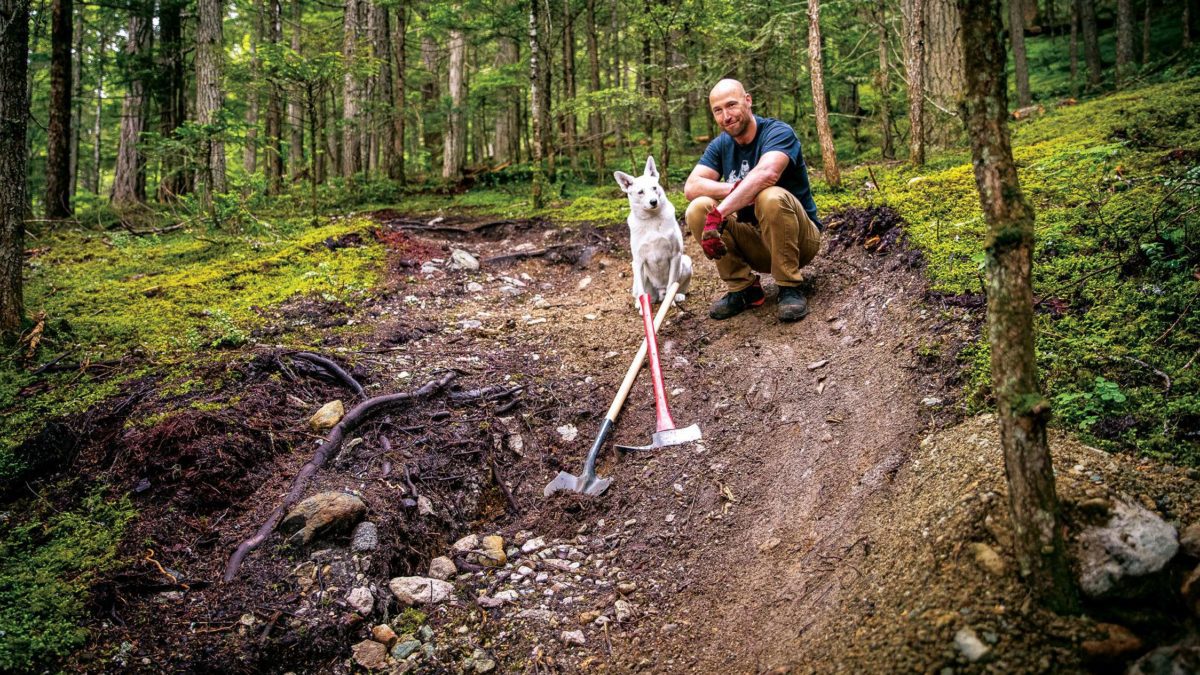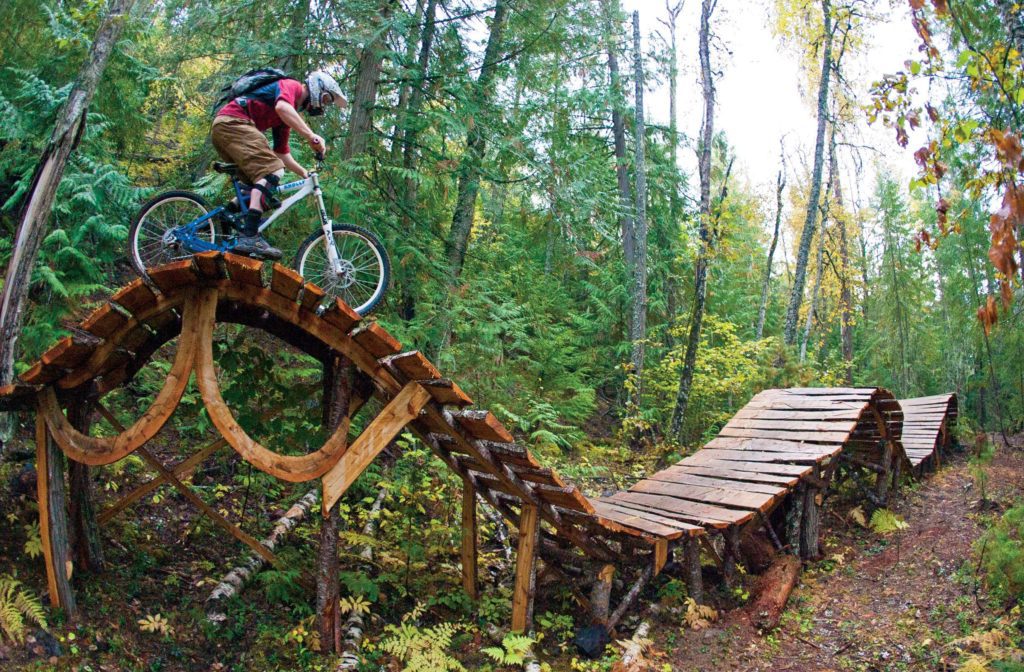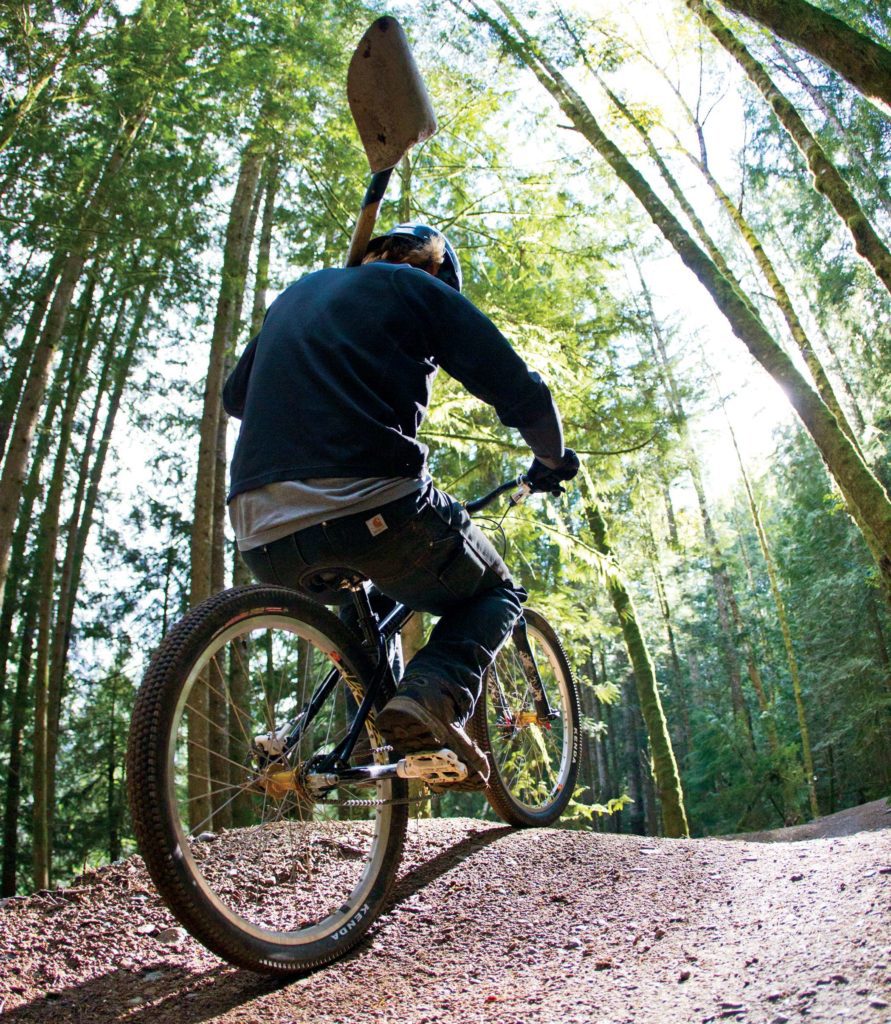What are the costs of building rogue mountain bike trails?
Can trail building go legit without losing its way?
 Photo by:
John Entwistle
Photo by:
John Entwistle
By Ryan Stuart
When Scott Veach and Ben Haggar started trail building on Blackcomb Mountain, they had no idea they were digging up a controversy. It was 2015. The two friends were unemployed and inspired.
On the lower slopes of Blackcomb Mountain, they had discovered “a beautiful forest with amazing terrain and good climbing access,” Veach says. “We saw it as a really good area to build a mountain bike trail. We thought we were being respectful.”
As they imagined what they were about to build, they also considered how it would fit into the wider trail network, how they’d minimize their impact on the ecosystem, how they’d keep it safe for other riders, how they’d build it to reduce erosion, and even how they’d commit to the maintenance it would require in perpetuity.
Dark Crystal unearths controversy
Throughout the summer of 2015, Haggar and Veach put in 2,400 hours weaving a nearly 3-km line through old growth forest, off granite slabs and through gardens of moss. They called their secret trail Dark Crystal.
The next year, word got out. One person told another. The builders posted about the trail on Instagram. People raved about the craftsmanship. Trail speed carried through almost every feature. Corners were predictable and smooth. It was all through an enchanting and wild-feeling forest. In the end, riders were spat out on the doorstep of Blackcomb Village. Dark Crystal was soon one of the most popular trails in the Whistler area – and that was a problem.
“We wanted to complement the landscape with something fun,” Veach says. He adds “We thought we were adding an enjoyable aspect to the forest and another outlet to ride in an increasingly busy valley.” We thought we were helping things. We didn’t think by building it illegally we were causing a conflict.”

Before Veach and Haggar started building, they had checked to make sure Dark Crystal wasn’t in a park or on private land. But they didn’t talk to Whistler Blackcomb, now owned by Vail Resorts, or the Whistler Off Road Cycling Association, the group that manages and maintains most of the trails outside the resort’s bike park. If they had, they would have learned that every metre of the trail fell within Whistler Blackcomb’s controlled recreation area – publicly owned, Crown land within their exclusive tenure. Now, because Veach and Haggar had done such a good job of trail building on what is essentially private land, not only was Dark Crystal in danger, but so was the future of other trail building dreams in the Whistler area.
This is the conundrum of going rogue.
The Process (and some problems)
The rules for creating a trail from scratch vary depending on jurisdiction and land ownership, but almost everywhere in Canada there is a process for doing it legally. For a variety of reasons – everything from ignorance to rebellion – many trail builders don’t bother. Often, the riding community reveres the builders’ transgressions; everyone loves a new trail. Their creations are often quietly adopted or actively sanctioned into trail networks.
As the sport grows and trail networks expand, especially because of the pandemic trail building boom, there is a real risk that rogue building will have a negative effect on the entire riding community. Yet, when the incentives are right, illegal builders – including Veach, Haggar and others – see the value in going legit.
“Even if rogue builders build an amazing trail, they 100 per cent do damage,” says AJ Strawson, the executive director of the International Mountain Bike Association’s Canadian chapter. “I’d argue the outcome of building a trail is not as important as the process of how it got there.”
The three kinds of builders
Strawson figures there are three main types of rogue trail builders. The first and most common are the ignorant. They don’t know they need some kind of approval to build a trail. Strawson says this is especially common in rural areas, particularly in places without an established mountain biking community. As riders have done since the sport’s inception, they build out of need for a place to ride. It’s only later that they might learn what they did was illegal or pissed off a landowner.
The second group arises out of the process of trying to do the right thing. While every jurisdiction is a little different, a fully sanctioned trail will likely require an environmental assessment, community and stakeholder consultations and landowner approval. “Just finding out who owns the land can be challenging,” says Strawson. “You have to jump through a bunch of hoops to do it the right way.”
Each step can take a long time, anywhere from months to years. Sometimes delays are for legitimate reasons – for example, a First Nation wants to assess the area for cultural importance. Other times, delays come with no explanation, except bureaucracy. “I’m not sure what it is about mountain bikers, but we’re always in a hurry,” says Strawson. “We’re so impatient.”
At the end of the whole process, there’s the potential of rejection or major compromises. Somewhere along the way, many trail builders give up and just get to work. This decision often leads to the third type of rogue builder: the kinds who know about the regulatory hoops, but are so disillusioned and frustrated by the process that they choose to ignore it.

McIntosh’s winding road to building the dream, legally
Riley McIntosh has been part of all three groups. He started his trail building career as a tween with a two-km loop behind his family’s house in the Cowichan Valley on Vancouver Island. Out of high school, he graduated to building gap jumps and wooden features in the Whistler Bike Park. When the season was over, he migrated east to Nelson, B.C., for the winter and stayed for a job with Freeride Entertainment to build stunts, starting in 2006, for the company’s New World Disorder films.
Slowly a dream coalesced in his mind: to build a backcountry mountain bike area, like snow-cat or heli skiing, with helicopter drop zones and a provincial tenure. It was a novel idea at the time and, as such, had never been done before. After a lot of work, he applied for a tenure – the right to work on Crown land – which the B.C. government was legally required to respond to within 60 days. Then the deadline passed without a yes or no. “I got frustrated and just started building,” McIntosh says.
Powerslave
Throughout two years he built Powerslave, a 3.4-km-long, 500-m-vertical-drop trail in the Selkirk Mountains. The illegal effort pissed off the local weed farmers and stirred up controversy in and around Nelson. The upshot was the publicity also forced the provincial government to grant the tenure. To secure the money and insurance required, McIntosh partnered with Retallack, a cat ski operation.
It was a victory and a turning point for McIntosh. After a few years helping build out Retallack’s mountain bike trail network, he returned to the Cowichan Valley. The relatively warm winters make the east coast of Vancouver Island one of the nation’s few year-round mountain biking destinations. The trail networks were expanding to accommodate the fast-growing community. McIntosh, energized and motivated, wanted to be a part of it.
But land ownership in the area is also an anomaly. Where most of the province is unceded Crown land, southeastern Vancouver Island is predominantly privately owned by logging companies. Concerned about liability, they were never going to give permission to build a trail on their properties. At the same time, they turned a blind eye to the trail building. It created an awkward situation: mountain bikers were trespassing, trail building was illegal and a feller-buncher could obliterate a network without any consultation or compensation.

A new tactic on Vancouver Island
Into this Wild West stepped the United Riders of Cumberland (UROC), a volunteer club largely started to advocate for mountain biking with local landowners. Like the Cowichan area, private forest lands surround the village of Cumberland. A growing trail network climbed from town through the trees. Over and over again, the logging companies destroyed the hard work and the infrastructure that was drawing increasing numbers of riders to town, both to live and to spend money. With the backing of the village, UROC started working with the main landowners to build a copasetic relationship.
“This is a town built on coal mining and logging,” says Jeremy Grasby, one of the founders of UROC. “Once we stopped fighting industry and started working with them, everything changed.”
In 2015, the club signed a land use agreement, which passed liability for trail users from the landowners to UROC. Overnight, the trails went from illegal to legal. UROC and Cumberland could market the area as a riding destination. The logging companies have agreed to rehabilitate trails after they log.
More than anything, the agreement brings trail building out of the woods and into the open, says Grasby. He points to a trail like Climax, a two-part climb in the heart of Cumberland’s network. It originally meandered through a nice stand of second growth trees, but within a few years of completion, the landowner logged it, leaving riders to reconstruct the trail through a clear cut.
“Now we have a relationship with the logging companies where they tell us their plans years ahead of time,” Grasby explains. “We can plan our trail building with them. We don’t waste our time. That was never going to happen when we were building illegally.”
Building above board for the greater good
Riders in Cowichan, including McIntosh, learned from Cumberland. When he returned to the Island from Nelson, he helped start the Cowichan Trail Stewardship Society, an advocacy group working to adopt illegal trails and networks under the society’s liability insurance
“I’m committed to never building illegally again, because it’s a waste of time for everyone,” McIntosh says. “Consider the amount of time and effort you put into building a trail as an investment. Would you put money into something where you had no idea if you were getting a return? Of course not.”
Today, McIntosh works with Indigenous groups around Vancouver Island to build trails and introduce mountain biking to youth. He says watching kids pedal into the woods on a trail they helped build is the most rewarding thing he’s done.

Building for everyone
It’s the feeling of inclusion that’s the real payoff for jumping through the legal hoops, says Stawson. “The benefit of not asking is that you can do whatever you want,” he says. “But the trail builder is one voice out of an entire community and that voice is probably more skilled, more advanced than most riders. Inviting everyone’s input and having the awkward conversations is how we know we are providing the right type of recreation for the entire community.”
A rogue trail builder rarely has the big picture of the trail network in mind. They might not consider the overall difficulty mix, or know about other planned projects or consider maintenance requirements or logging plans.
But rogue building is also a communication tool, says Strawson. “Rogue builders are saying, ‘The existing trails don’t reflect how I want to ride,’” Strawson says. “If we’re building the right mix of new trails, so they represent the entire riding community, no one is going to go out and build on their own.”
The struggle is keeping up with the demand in a fast-growing sport. The threat if we don’t, could be significant. Already there’s a growing expectation that trail builders need to consult with First Nations, says Strawson, though he acknowledges the specifics of what “meaningful consultation” requires remain vague. To him, environmental groups concerned about the impact of more trail building on ecosystems or busier trails on wildlife are a more immediate concern, especially with all the new singletrack that emerged in the past two years from available hands during COVID-related lockdowns and layoffs.
“There’s not a ton of negative attention about rogue trail building in the public sphere, yet,” he says. “But we could see some really significant threats to access in the future – particularly the next time we show up at a table and say we need new trails.”
The path forward involves both a carrot and a stick, he says. Advocacy groups need to promote the proper process to trail building. Various levels of government need to provide funding and support to help build new trails respectfully and to speed up the approval process. Land managers have to start combatting rogue building. “It’s no different than poaching wildlife or polluting a river,” says Strawson. “Land managers have been entrusted by the public to police and enforce the rules. They’ve not done a lot so far.”
Dark Crystal casts new light in Whistler
Scott Veach has an even more effective solution in mind. After the Dark Crystal controversy erupted in 2016, none of the affected stakeholders overreacted. Instead, Whistler Blackcomb and WORCA sat down with Ben Haggar and Veach. The trail builders professed their ignorance and everyone agreed to move forward. Both groups decided to sanction the trail and adopt it into the greater trail network. Veach and Haggar committed to maintaining the trail – a 120-hours-a-year investment.
“In hindsight, it’s tough to say if Dark Crystal would have happened if we’d tried to get approval first,” says Veach, who now sits on the WORCA board. “Other trail proposals within Whistler Blackcomb’s tenure have gone through the official process and Vail hasn’t approved any of them. I don’t want to encourage people to just go for it, but sometimes you need to make stuff happen.”
It’s worked out for the pair – Dark Crystal is the ultimate resumé piece. Both Veach and Haggar are now trail building professionally. They spent the late summer and fall working on heli-bike trails in the Coast Mountains.
“If you want to stop rogue building, pay them to build trails,” Veach says. “Now that I’m getting paid to build, I’ll never build rogue again.”
This story originally appeared in the February/March 2022 issue of Canadian Cycling Magazine
